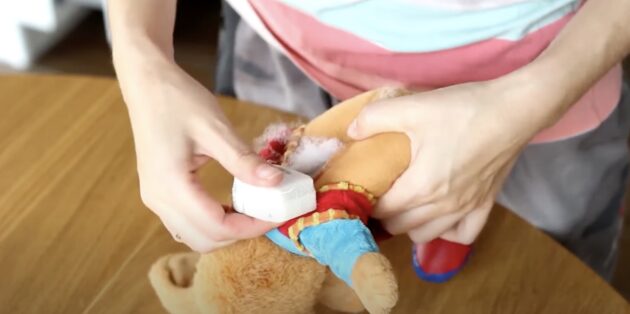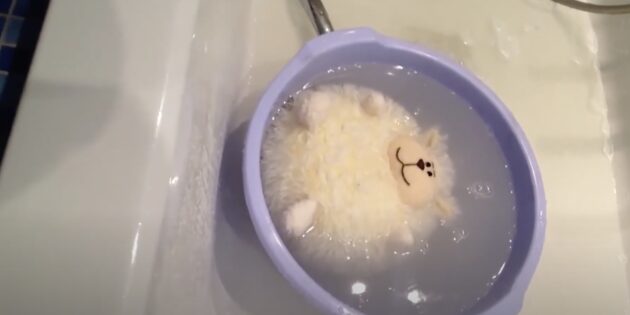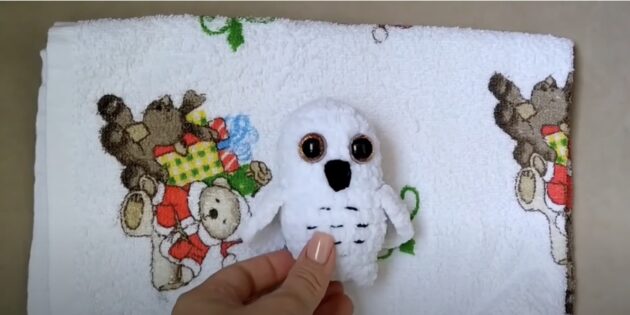1. First, carefully inspect the toys. All holes and split seams need to be mended beforehand, it is also worth sewing poorly fixed fittings, beads and other decor.
2. Toys that are too big should not be washed in a typewriter. They may simply not fit into the drum or even damage the equipment. It is better to wash such products by hand or take them to the dry cleaner.
3. Study the composition of the toy filler. Down, feathers and sawdust can clump together after machine pressing, so it is better to clean products with such materials manually.
4. Toys that have mechanisms, microchips, wires and batteries should definitely not be subjected to the usual washing, otherwise the gizmos will simply fail. If possible, carefully loosen the seam, remove the insides, and then sew up. After washing and drying, you will need to put everything back in place. When the mechanism cannot be removed, the toy can be carefully cleaned from the outside by hand.

5. Before sending toys with various accessories, lace, embroidery and other decorative elements to the machine, put each one individually in special laundry bags. This will not only help to keep all the jewelry intact, but also protect the equipment from possible damage.
6. Carefully study the information on the product label, if it has been preserved. As a rule, the maximum water temperature is indicated there, as well as washing, pressing and drying modes. Perhaps the manufacturer does not recommend washing the toy at home at all and allows only professional dry cleaning.
7. All toys must be dusted off or thoroughly vacuumed before washing.
Various powders, gels and liquid detergents can be used for both hand and machine washing. When it comes to cleaning children's toys, try to choose special children's or hypoallergenic household chemicals.
You can also wash toys manually with ordinary baby soap or shampoo for hair. However, these remedies may be powerless against complex contaminants. Household soap does a good job with persistent stains (72%), but it should be used with caution to clean white things so that there are no yellowish streaks on the fabric.
Fill the basin with water at a temperature of no more than 40 degrees (it should be warm, but not hot). You can use a bathtub to wash large toys. Add the amount of powder or gel recommended by the manufacturer of the product. Instead, you can dissolve a handful of soap, ground on a coarse grater, or a few drops of shampoo in the liquid until foam forms. Immerse the toy in the basin so that the water covers it completely, and leave it for 20-30 minutes.

After that, additionally lather overly soiled areas and, if necessary, rub them with your hands, sponge or soft brush. Then gently squeeze the product and rinse several times in clean cold water until the liquid becomes transparent and the foam disappears.
Then you can additionally rinse things with conditioner for laundry — this will soften the pile of the toy, and it will be less electrified. Gently squeeze the product again, without twisting or stretching it too much.
Load the toys into the drum. It is not necessary to stuff it to capacity: objects should be placed freely.
Add the right amount of detergent and conditioner to the powder dispenser. Choose the mode of gentle care, delicate or hand washing. The spin speed should be no more than 600 revolutions. The optimal temperature is no higher than 30 degrees, but sometimes toy manufacturers allow washing in hotter water, so check the icons on the labels.
Start the machine. After washing, toys may be too wet due to low spin speeds, so take out the products, put them in a basin or other container and let the excess liquid drain.
If the device could not be carefully removed from the toy, you can clean it from the outside without soaking it completely in water.
To do this, pour warm, but not hot water into a deep container, add a few drops of shampoo, liquid soap or dishwashing detergent. Whisk the solution into a thick foam and apply it to the surface of the toy with a toothbrush. Thoroughly clean the product from the outside, and then wipe off the remaining foam with a slightly damp cloth or towel.

It is not necessary to dry soft toys vertically, securing them with clothespins on a rope: the product may deform, and the filler may get into lumps. Also, you do not need to put objects in the sun so that the fabric does not burn out.